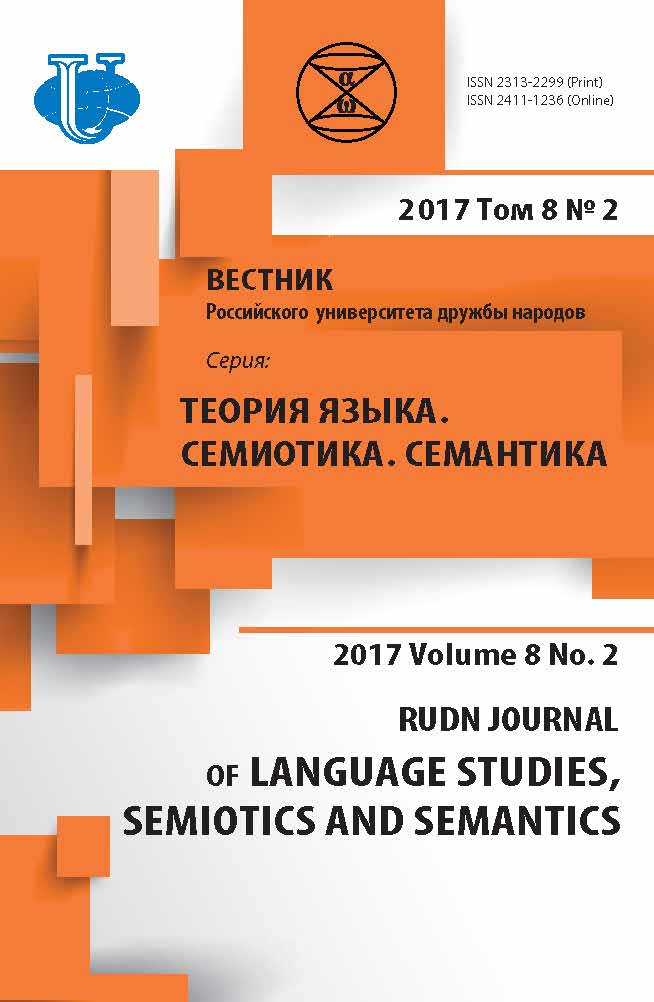The Semiotics of Religious Allusions in the Costa Rican National Variant of the Spanish Language
- Authors: Nikiforova S.A.1, Chesnokova O.S.2
-
Affiliations:
- Agencia Andaluza de Promoción Exterior (Extenda)
- RUDN University
- Issue: Vol 8, No 2 (2017)
- Pages: 309-319
- Section: ARTICLES
- URL: https://journals.rudn.ru/semiotics-semantics/article/view/16339
- DOI: https://doi.org/10.22363/2313-2299-2017-8-2-309-319
- ID: 16339
Cite item
Full Text
Abstract
The article is devoted to the reconstruction of religious allusions in the Costa Rican national variant of the Spanish language and analysis of its semiotics. The main research objectives include identifying and systematizing of religious allusions, explaining their motivation and defining patterns of using religious lexical units in the Costa Rican literary and everyday discourses. In order to do that we used the integral philological analysis method which allowed realize that religious allusions in the Costa Rican literary and everyday discourses vary from a separate lexical semantic unit to a phraseme in a composite sentence. Religious allusions are used by Costa Ricans for various purposes. The most common one is the intensification of speech which reflects the Costa Rican national way of communicating. The research results can serve as a basis for comparative studies of religious allusions in other national variants of the Spanish language.
About the authors
Svetlana Aleksandrovna Nikiforova
Agencia Andaluza de Promoción Exterior (Extenda)
Author for correspondence.
Email: sviet@rambler.ru
Pokryshkin St., 3, Moscow, Russia, 119602
Olga Stanislavovna Chesnokova
RUDN University
Email: tchesnokova_olga@mail.ru
Miklukho-Maclay St., 6, Moscow, Russia, 117198
References
- Wierzbicka, A. (2001). Understanding cultures through their keywords. Moscow: Language of Slavic Culture.
- Lotman, Y.M. (2000). Semiosphere. Cultureandblast. Insiderationalworlds. Articles. Research. Miscellenia (1968—1992). St. Petersburg: Art-SPB. (in Russ).
- Med, N.G. (2007). Axiological world view in Spanish lexis and phraseology. St. Petersburg: Publishing House of St. Petersburg University. (in Russ).
- Gutiérrez, J. (1989). Chinto Pinto. San José: Editorial de la Universidad de Costa Rica.
- Lyra, C. (1980). Cuentos de mi mía Panchita. San José: Editorial Costa Rica e Imprenta Nacional.
- Padilla Monge, M. (2013). Dichos y refranes ticos. Un “gallo pinto” de costarriqueñismos. San José: Jardine Ediciones.
- Quesada Pacheco, M. (2012). Nuevo Diccionario de Costarriqueñismos. Cartago: Editorial Tecnológica de Costa Rica.
- Zeledón Cartín, E. (1989). Leyendas constarricenses. Heredia: Museo de Cultura Popular.
- CR hoy. URL: http://www.crhoy.com/nacionales/lo-que-se-sabe-hasta-ahora-del-homicidio-multiple-en-liberia (accessed: 16.09.2016).
- Costa Rica subió al segundo lugar en Índice de Desarrollo Democrático para América Latina. Gobierno CR. URL: http://gobierno.cr/costa-rica-subio-al-segundo-lugar-en-indice-de-desarrollo-democratico-para-america-latina (accessed: 5.10.2016).
- Mathieu, J. URL: https://www.facebook.com/javier.mathieu.9?fref=pb&hc_location=friends_ tab&pnref=friends.all (accessed: 10.10.2016).
- El Mundo. URL: https://www.facebook.com/elmundoCR (accessed: 10.10.2016).
- Sistema Costarricense de Información Jurídica. URL: http://www.pgrweb.go.cr/scij/Busqueda/ Normativa/Normas/nrm_texto_completo.aspx?param1=NRTC&nValor1=1&nValor2=871&nValor3=95479&strTipM=TC (accessed: 5.10.2016).
- Teletica. URL: http://www.teletica.com/m/note.aspx?note=14968 (accessed: 10.10.2016).
- Teletica. URL: http://www.teletica.com/m/note.aspx?note=149685 (accessed: 10.10.2016).
Supplementary files












